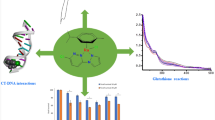Abstract
The synthesis, spectroscopic, and electrochemical properties of trans-[L(Pyr)(NH3)4RuII/III] (Pyr=py, 3-phpy, 4-phpy, 3-bnpy, or 4-bnpy; L=H2O, Guo, dGuo, 1MeGuo, Gua, Ino, or G7-DNA) are reported. As expected, the Pyr ligand slows DNA binding by trans-[(H2O)(Pyr)(NH3)4RuII]2+ relative to [(H2O)(NH3)5RuII]2+ and favors reduction of RuIII by about 150 mV. The pyridine ligand also promotes the disproportionation of RuIII to afford the corresponding complexes of RuII and, presumably, RuIV. For L=Ino, disproportionation follows the rate law: d[RuII]/dt=k 0[RuIII]+k 1[OH–][RuIII], k 0=(2.7±0.7)×10–4 s–1 and k 1=70±1 M–1 s–1.
Similar content being viewed by others
Author information
Authors and Affiliations
Additional information
Received: 11 May 1998 / Accepted: 3 March 1999
Rights and permissions
About this article
Cite this article
Zhao, M., Clarke, M. Trans-pyridine tetraammine complexes of RuII and RuIII with N7-coordninated purine nucleosides. JBIC 4, 318–324 (1999). https://doi.org/10.1007/s007750050318
Issue Date:
DOI: https://doi.org/10.1007/s007750050318




